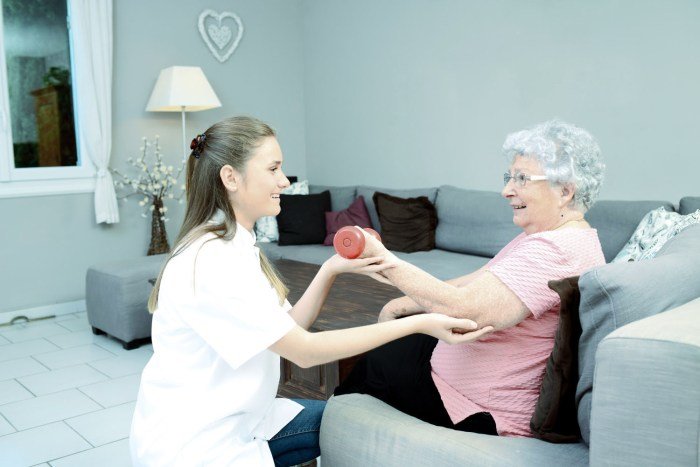Physical therapist home health care offers a convenient and personalized approach to rehabilitation, bringing the expertise of a physical therapist directly to your home. This allows individuals to receive specialized care in the comfort of their own surroundings, promoting faster recovery and improved independence.
From post-surgical recovery to managing chronic conditions, home health physical therapy caters to a wide range of needs. It involves a comprehensive assessment of an individual’s physical limitations and goals, followed by the development of a tailored treatment plan. This plan may include a variety of techniques, such as exercises, manual therapy, and education on proper movement and activity modifications.
Introduction to Physical Therapy in Home Health Care: Physical Therapist Home Health Care

Physical therapy is an essential part of healthcare, and home health care is a growing area where physical therapists play a vital role. Home health physical therapy provides personalized care and rehabilitation services in the comfort of a patient’s home.
The Role of Physical Therapists in Home Health Care
Physical therapists in home health care settings provide a wide range of services tailored to meet the unique needs of their patients. They work collaboratively with other healthcare professionals, including physicians, nurses, and occupational therapists, to develop comprehensive treatment plans.
The goal is to help patients regain their independence, improve their mobility, and manage pain and other health conditions.
Benefits of Receiving Physical Therapy at Home
Receiving physical therapy at home offers numerous advantages over traditional clinic-based settings.
- Convenience and Comfort:Home-based therapy eliminates the need for travel, allowing patients to receive treatment in a familiar and comfortable environment. This can be especially beneficial for individuals with limited mobility or those who find it difficult to leave their homes.
- Personalized Care:Home health physical therapists can provide highly individualized treatment plans based on the patient’s specific needs and goals. They have the flexibility to adapt their approach and incorporate various techniques to optimize patient outcomes.
- Increased Frequency and Duration of Treatment:Home visits allow for more frequent and longer sessions, enabling therapists to monitor progress closely and make adjustments as needed. This can lead to faster recovery and better results.
- Improved Patient Engagement:Receiving therapy in the home environment can encourage patients to actively participate in their rehabilitation. They are more likely to follow exercise programs and make lifestyle changes when they are comfortable and supported in their own surroundings.
Conditions That May Benefit from Home-Based Physical Therapy
Home-based physical therapy is suitable for a wide range of conditions, including:
- Post-Surgical Rehabilitation:Following surgery, patients often require physical therapy to regain strength, flexibility, and mobility. Home-based therapy allows for individualized care and personalized exercise programs to promote healing and recovery.
- Neurological Conditions:Stroke, spinal cord injuries, multiple sclerosis, and Parkinson’s disease can significantly impact mobility and functional independence. Home health physical therapists can provide specialized exercises and adaptive strategies to help patients regain lost function and improve their quality of life.
- Orthopedic Conditions:Fractures, arthritis, and joint replacements can cause pain, stiffness, and limited mobility. Home-based physical therapy can help patients manage pain, improve range of motion, and regain strength and balance.
- Geriatric Care:As people age, they may experience age-related decline in mobility, balance, and strength. Home health physical therapists can provide fall prevention programs, exercises to improve balance and coordination, and assistance with activities of daily living.
- Chronic Pain Management:Chronic pain conditions, such as back pain, neck pain, and fibromyalgia, can significantly impact a person’s ability to function. Home-based physical therapy can help patients manage pain, improve flexibility, and learn strategies for self-management.
Common Physical Therapy Services Offered at Home
Home health physical therapy offers a range of services designed to improve mobility, reduce pain, and enhance overall function for individuals recovering from illness or injury. These services are tailored to meet specific needs and goals, enabling patients to regain independence and participate actively in their daily lives.
Common Physical Therapy Services
Home health physical therapy encompasses a variety of services, each with distinct goals and techniques. These services are tailored to address individual needs and help patients achieve their desired outcomes.
| Service | Description | Goals | Techniques |
|---|---|---|---|
| Balance and Gait Training | This service focuses on improving balance and coordination, enhancing safe and independent walking. |
|
|
| Strength Training | Strength training aims to improve muscle strength, endurance, and power. |
|
|
| Range of Motion Exercises | Range of motion exercises focus on restoring and maintaining joint flexibility and mobility. |
|
|
| Pain Management | Pain management techniques aim to reduce pain and discomfort, improve function, and enhance quality of life. |
|
|
The Importance of a Personalized Treatment Plan

A personalized physical therapy plan is crucial for maximizing your recovery and achieving your rehabilitation goals. It’s not a one-size-fits-all approach, but rather a tailored strategy that considers your unique needs, goals, and circumstances.
The Process of Creating a Personalized Physical Therapy Plan
The creation of a personalized physical therapy plan involves a comprehensive assessment and collaborative discussion between you and your physical therapist. This process ensures that the plan is tailored to your specific requirements and effectively addresses your needs.
Assessment
- Initial Evaluation:Your physical therapist will conduct a thorough evaluation, including a detailed medical history review, a physical examination, and a functional assessment. This assessment helps them understand your current condition, limitations, and functional goals.
- Functional Assessment:This assessment evaluates your ability to perform everyday activities, such as walking, climbing stairs, dressing, and bathing. It helps identify areas where you need assistance and determine the specific exercises and interventions that will help you regain independence.
- Goal Setting:Together, you and your physical therapist will set realistic and achievable goals. These goals can include reducing pain, improving mobility, increasing strength, and enhancing functional independence.
Treatment Plan Development
- Based on the assessment, your physical therapist will develop a personalized treatment plan that Artikels the specific exercises, interventions, and strategies that will help you achieve your goals.
- The plan may include:
- Manual therapy techniques, such as massage, joint mobilization, and soft tissue mobilization
- Therapeutic exercises, such as strengthening, stretching, and balance exercises
- Functional training, which focuses on activities of daily living
- Modalities, such as heat, cold, ultrasound, and electrical stimulation
- Assistive devices, such as canes, walkers, or braces
- Patient education and home exercise programs
Factors Influencing the Development of a Treatment Plan
Several factors can influence the development of a personalized physical therapy plan. Understanding these factors helps you appreciate the individualized nature of your treatment plan.
Factors
- Your Medical History:Your past medical conditions, surgeries, and medications can all influence your treatment plan.
- Your Current Condition:The specific diagnosis, severity of symptoms, and pain level will be considered when developing your plan.
- Your Functional Goals:Your goals, such as returning to work, participating in sports, or simply being able to walk around your home independently, will guide the treatment plan.
- Your Lifestyle:Your daily activities, hobbies, and level of physical activity will be taken into account to ensure the treatment plan is realistic and sustainable.
- Your Preferences:Your personal preferences and any concerns you have about the treatment plan will be discussed and addressed.
Common Exercises and Activities for Home-Based Physical Therapy

Home-based physical therapy exercises and activities are tailored to address individual needs and goals. These exercises aim to improve strength, flexibility, balance, and coordination, ultimately enhancing overall function and quality of life.
Strength Training Exercises
Strength training exercises are crucial for maintaining and improving muscle mass and strength. They are particularly beneficial for individuals with conditions that affect mobility, such as arthritis, stroke, or spinal cord injuries.
- Resistance Bands:Resistance bands are versatile tools that can be used for a wide range of exercises, targeting various muscle groups. Examples include bicep curls, tricep extensions, and shoulder presses.
- Weight Lifting:Light weights, such as dumbbells or water bottles, can be incorporated into exercises like squats, lunges, and rows, promoting muscle strength and endurance.
- Bodyweight Exercises:These exercises utilize the body’s own weight for resistance. Examples include push-ups, planks, and squats, which can be modified to suit different fitness levels.
Flexibility and Range of Motion Exercises
Flexibility and range of motion exercises are essential for maintaining joint health and preventing stiffness. These exercises are particularly important for individuals with limited mobility, such as those recovering from surgery or dealing with chronic pain.
- Stretching:Stretching involves holding a muscle in a lengthened position for a specific duration, improving flexibility and reducing muscle tension. Examples include hamstring stretches, quadriceps stretches, and shoulder stretches.
- Yoga:Yoga incorporates a series of poses that enhance flexibility, balance, and strength, promoting overall well-being.
- Tai Chi:Tai Chi is a gentle form of exercise that focuses on slow, flowing movements, improving balance, flexibility, and coordination.
Balance and Coordination Exercises, Physical therapist home health care
Balance and coordination exercises are crucial for maintaining stability and preventing falls, especially for individuals with conditions that affect balance, such as Parkinson’s disease or vestibular disorders.
- Single-Leg Stances:Standing on one leg for short periods strengthens ankle and leg muscles, improving balance and stability.
- Heel-Toe Walking:Walking heel-to-toe across a room challenges balance and coordination, improving stability and reducing fall risk.
- Tandem Stance:Standing with one foot directly in front of the other, heel to toe, enhances balance and coordination.
Cardiovascular Exercises
Cardiovascular exercises are beneficial for improving heart health, increasing stamina, and promoting overall fitness. These exercises can be modified to suit individual needs and limitations.
- Walking:Walking is a low-impact exercise that can be easily incorporated into daily routines, improving cardiovascular health and promoting mobility.
- Cycling:Cycling is a great way to improve cardiovascular fitness and leg strength. Stationary bikes or recumbent bikes are suitable options for individuals with limited mobility.
- Swimming:Swimming is a low-impact exercise that provides a full-body workout, minimizing stress on joints.
Visual Representation of a Home-Based Physical Therapy Session
[Image of a living room with a person using resistance bands, another person doing stretches on a yoga mat, and a third person practicing balance exercises using a cane.] This image illustrates a home-based physical therapy session with a variety of exercises, equipment, and modifications for different needs.
Collaboration with Other Healthcare Professionals

In the realm of home health care, a collaborative approach is crucial for optimizing patient outcomes. Physical therapists play a vital role in this collaborative effort, working closely with other healthcare professionals to provide comprehensive and coordinated care.
Physical therapist home health care offers personalized treatment plans tailored to your individual needs and recovery goals. For comprehensive healthcare services in the Bedford-Stuyvesant area, consider the Bedford Stuyvesant Family Health Center. They can help you find the right physical therapist and connect you with other resources to support your recovery journey.
Examples of Collaboration
Effective collaboration between physical therapists and other healthcare providers is essential for ensuring that patients receive the most appropriate and effective care. Here are some examples of how physical therapists collaborate with other healthcare professionals:
- Physicians:Physical therapists work closely with physicians to develop and implement personalized treatment plans. They communicate regularly with physicians to update them on patient progress and discuss any changes in treatment plans. They also collaborate with physicians to identify any potential medical issues that may affect a patient’s ability to participate in physical therapy.
- Nurses:Physical therapists collaborate with nurses to monitor patients’ overall health status and ensure that they are safe and comfortable during physical therapy sessions. They also work with nurses to address any pain or other symptoms that patients may experience.
- Occupational Therapists:Physical therapists often work with occupational therapists to address patients’ functional limitations and improve their ability to perform daily activities. They may collaborate to develop strategies for improving patients’ mobility, strength, and coordination.
- Speech-Language Pathologists:For patients who have difficulty swallowing or speaking, physical therapists may collaborate with speech-language pathologists to address these challenges. They may work together to develop exercises and strategies to improve patients’ swallowing function and communication skills.
- Social Workers:Physical therapists may collaborate with social workers to address patients’ social and emotional needs. They may work together to identify and address any barriers that patients may face in receiving physical therapy services.
Benefits of Interdisciplinary Care
Interdisciplinary care in home health settings offers numerous benefits for patients, including:
- Improved Patient Outcomes:When healthcare professionals work together, they can develop more comprehensive and effective treatment plans that address all of a patient’s needs. This can lead to better outcomes, including faster recovery times, reduced pain, and improved functional abilities.
- Increased Patient Satisfaction:Patients who receive interdisciplinary care often report higher levels of satisfaction with their care. This is because they feel like they are being treated as a whole person, and that their individual needs are being met.
- Reduced Healthcare Costs:Interdisciplinary care can help to reduce healthcare costs by preventing unnecessary hospitalizations and readmissions. This is because it helps to identify and address potential problems early on, before they become more serious.
Technology in Home Health Physical Therapy

Technology has revolutionized the field of physical therapy, particularly in the home health setting. The integration of various technological tools has enhanced patient care, improved outcomes, and expanded the reach of physical therapy services.
Telehealth in Home Health Physical Therapy
Telehealth, also known as telemedicine, utilizes technology to deliver healthcare services remotely. In the context of home health physical therapy, telehealth platforms enable therapists to provide virtual consultations, monitor patient progress, and guide exercises remotely.
- Virtual Consultations:Therapists can conduct initial assessments, provide treatment plans, and answer patient questions through video conferencing platforms. This eliminates the need for in-person visits, especially for patients who have difficulty traveling.
- Remote Monitoring:Wearable devices and smartphone apps can track patient movement, gait, and exercise adherence. Therapists can access this data remotely to monitor progress and adjust treatment plans as needed.
- Interactive Exercise Programs:Telehealth platforms can provide patients with access to guided exercise videos, personalized programs, and real-time feedback. This helps ensure patients are performing exercises correctly and safely at home.
Benefits of Technology in Home Health Physical Therapy
The use of technology in home health physical therapy offers numerous benefits to both patients and therapists.
- Improved Patient Convenience:Telehealth eliminates the need for travel, making physical therapy more accessible to patients with mobility limitations or those living in remote areas.
- Enhanced Patient Engagement:Interactive exercise programs and remote monitoring can increase patient engagement and adherence to treatment plans.
- Increased Efficiency:Telehealth platforms streamline communication and data sharing, allowing therapists to manage their caseload more efficiently.
- Cost-Effectiveness:Telehealth can reduce the need for in-person visits, potentially lowering overall healthcare costs.
Limitations of Technology in Home Health Physical Therapy
While technology offers significant advantages, there are also some limitations to consider.
- Technological Barriers:Patients may lack access to reliable internet connections or compatible devices, limiting their ability to participate in telehealth services.
- Privacy Concerns:Telehealth platforms require secure data storage and transmission to protect patient privacy.
- Lack of Physical Examination:Therapists cannot perform hands-on assessments or manual therapy techniques through telehealth.
- Limited Social Interaction:Virtual consultations may not provide the same level of social interaction as in-person visits, which can be important for patient motivation and engagement.
Safety and Considerations for Home-Based Physical Therapy

While home-based physical therapy offers convenience and comfort, it’s crucial to prioritize safety. This section delves into potential safety concerns and provides guidance on creating a safe and effective home therapy environment.
Physical therapist home health care can provide personalized treatment plans tailored to your specific needs. If you’re looking for a way to supplement your physical therapy with some aquatic exercise, you might want to check out the LA Fitness pool.
The buoyancy of water can help reduce stress on your joints, making it a great option for individuals recovering from injuries or managing chronic conditions. After your aquatic workout, a physical therapist can guide you through specific exercises to further improve your mobility and strength.
Potential Safety Concerns in Home-Based Physical Therapy
Home-based physical therapy presents unique safety considerations compared to a clinical setting. Understanding these potential risks is vital for both patients and therapists to mitigate hazards and ensure a positive therapeutic experience.
- Falls:Home environments can be uneven, with stairs, rugs, and clutter that increase the risk of falls, especially for individuals with mobility limitations.
- Improper Exercise Technique:Without proper supervision, patients may perform exercises incorrectly, leading to strain, injury, or exacerbation of existing conditions.
- Medication Interactions:Certain medications can affect balance, coordination, and strength, increasing the risk of accidents during therapy sessions.
- Environmental Hazards:Home environments may contain potential hazards like loose wires, sharp objects, or slippery surfaces that could cause injury.
- Lack of Emergency Equipment:Unlike a clinic, homes may not have immediate access to emergency equipment, such as defibrillators or oxygen, in case of a medical emergency.
Creating a Safe Home Therapy Environment
Creating a safe home environment for physical therapy is essential for patient well-being and successful rehabilitation. Here are some tips to ensure a secure and effective therapy space:
- Clear Pathways:Remove clutter, rugs, and other obstacles from areas where therapy exercises will be performed. Ensure clear pathways for walking and movement.
- Adequate Lighting:Ensure sufficient lighting throughout the therapy area to prevent falls and improve visibility during exercises.
- Secure Furniture:Ensure furniture is stable and will not move or tip during exercises. Secure loose items like throw rugs or curtains that could pose a tripping hazard.
- Proper Equipment:Use appropriate and well-maintained equipment for therapy exercises. Ensure equipment is sized and adjusted correctly for the patient’s needs.
- Emergency Contact Information:Keep emergency contact information readily available, including the therapist’s number, local emergency services, and any relevant medical information.
The Role of Patients and Caregivers in Promoting Safety
Patients and caregivers play a crucial role in ensuring a safe and effective home therapy experience. Open communication and collaboration are vital.
Physical therapist home health care focuses on helping individuals regain mobility and strength in the comfort of their own homes. This often involves incorporating exercises that improve balance, coordination, and overall fitness, which are crucial for maintaining an active lifestyle.
For those seeking more adventurous activities, exploring the world of movement climbing and fitness can be a rewarding and challenging endeavor. However, it’s important to consult with a physical therapist to ensure proper training and preparation before embarking on such activities, particularly if you’re recovering from an injury or have underlying health conditions.
- Open Communication:Patients should inform their therapist about any concerns, limitations, or changes in their condition, including medication changes or new symptoms.
- Follow Instructions:Patients should carefully follow the therapist’s instructions regarding exercise techniques, safety precautions, and home exercise programs.
- Active Participation:Patients should actively participate in their therapy by asking questions, expressing concerns, and practicing exercises diligently.
- Caregiver Support:Caregivers should provide support and assistance to patients during exercises, ensuring a safe and comfortable environment.
- Emergency Preparedness:Caregivers should be familiar with emergency procedures, including how to contact emergency services and what to do in case of a medical emergency.
The Benefits of Home Health Physical Therapy

Receiving physical therapy in the comfort of your own home offers numerous advantages, making it a desirable option for many individuals. Home-based therapy provides a personalized and convenient approach to recovery, enabling patients to regain their mobility and independence at their own pace.
Comparing Home-Based and Clinic-Based Therapy
Home health physical therapy offers several benefits compared to traditional clinic-based therapy. Here’s a breakdown of the key differences:
- Convenience and Comfort:Home-based therapy eliminates the need for travel, appointments, and waiting times. Patients can receive treatment in a familiar and comfortable environment, reducing stress and anxiety.
- Personalized Care:Home health therapists can tailor treatment plans to the specific needs and goals of each patient. They have the flexibility to adjust exercises and activities based on the patient’s individual progress and limitations.
- Increased Participation in Treatment:In a home setting, patients are more likely to actively participate in their therapy sessions. The familiar environment fosters a sense of ownership and responsibility, leading to better adherence to the treatment plan.
- Enhanced Safety:Home-based therapy can be particularly beneficial for individuals with mobility limitations or safety concerns. The therapist can assess the home environment and make recommendations to minimize risks and ensure a safe treatment experience.
Improving Quality of Life and Independence
Home health physical therapy plays a crucial role in improving quality of life and promoting independence for individuals recovering from injuries, illnesses, or surgeries. Here’s how:
- Increased Mobility and Function:Physical therapy exercises and activities aim to restore strength, flexibility, balance, and coordination. This helps patients regain mobility and participate in everyday activities with greater ease.
- Pain Management:Therapists can use various techniques, such as manual therapy, modalities, and exercise, to reduce pain and discomfort. This allows patients to move more freely and participate in activities they enjoy.
- Reduced Risk of Falls:Home-based physical therapy can address balance and gait issues, reducing the risk of falls and promoting safety in the home environment.
- Improved Overall Health and Well-being:Regular physical activity, as prescribed by a therapist, can enhance cardiovascular health, improve mood, and boost overall well-being.
Finding a Home Health Physical Therapist

Finding a qualified and experienced home health physical therapist is crucial for receiving effective and personalized care. Several resources and tips can help you make an informed decision and find the right therapist for your needs.
Resources for Finding a Home Health Physical Therapist
Finding a home health physical therapist involves utilizing various resources. These resources can provide you with a list of qualified professionals in your area.
- Your Physician or Healthcare Provider:Your doctor or other healthcare provider can often recommend a home health physical therapist based on your specific needs and medical history. They may have a network of trusted professionals they work with regularly.
- Home Health Agencies:Home health agencies typically have a team of physical therapists on staff. Contacting several agencies in your area can help you compare their services, qualifications, and experience.
- Professional Organizations:The American Physical Therapy Association (APTA) maintains a directory of physical therapists across the country. You can use their website to search for therapists in your area and filter by specialization and other criteria.
- Online Directories:Websites like Healthgrades, Vitals, and Zocdoc provide online directories of healthcare providers, including physical therapists. These directories often include patient reviews and ratings to help you make informed decisions.
Tips for Selecting a Home Health Physical Therapist
Once you have a list of potential therapists, it is important to consider several factors to ensure you choose the right one for you.
- Experience and Qualifications:Look for a therapist who is licensed and certified in your state and has experience treating your specific condition. Ask about their years of experience in home health settings and their areas of expertise.
- Communication and Personality:It is essential to feel comfortable and confident with your therapist. Schedule a consultation to discuss your needs and ask questions about their approach to treatment. Ensure you feel heard and understood.
- Treatment Approach:Inquire about the therapist’s approach to home health physical therapy. Do they focus on a specific method or utilize various techniques? Understanding their philosophy and approach can help you determine if they align with your preferences.
- Availability and Scheduling:Discuss the therapist’s availability and scheduling flexibility. Home health physical therapy often requires flexibility to accommodate your schedule and home environment. Ensure the therapist can work with your needs.
Insurance Coverage and Payment Options
Before scheduling appointments, it is essential to understand your insurance coverage and payment options for home health physical therapy.
- Insurance Coverage:Contact your insurance provider to determine your coverage for home health physical therapy. Verify the specific benefits, limitations, and any pre-authorization requirements.
- Co-pays and Deductibles:Be aware of any co-pays or deductibles you may be responsible for. Ask the therapist or home health agency about their billing practices and payment options.
- Out-of-Pocket Costs:If your insurance coverage is limited, inquire about out-of-pocket costs for physical therapy services. Some therapists may offer payment plans or sliding-scale fees.
Ending Remarks

Home health physical therapy provides a valuable service for individuals seeking personalized care and convenient rehabilitation. By working closely with other healthcare professionals and utilizing technology when appropriate, physical therapists ensure a safe and effective treatment experience. The benefits of home-based therapy extend beyond physical improvements, encompassing enhanced quality of life, increased independence, and a greater sense of well-being.
Helpful Answers
What are the qualifications of a home health physical therapist?
Home health physical therapists are licensed professionals who have completed a Doctor of Physical Therapy (DPT) degree and are certified by the state in which they practice. They have specialized training in providing physical therapy services in a home setting.
How do I find a qualified home health physical therapist?
You can consult with your primary care physician or other healthcare providers for recommendations. You can also search online directories or contact your insurance company for a list of in-network providers.
What are the costs associated with home health physical therapy?
The cost of home health physical therapy varies depending on your insurance coverage, the frequency and duration of treatment, and the specific services provided. It’s important to discuss payment options and potential out-of-pocket expenses with your provider.
Is home health physical therapy covered by insurance?
Most health insurance plans cover home health physical therapy, but it’s crucial to check your policy details for coverage specifics and any pre-authorization requirements. Your provider can assist in navigating the insurance process.